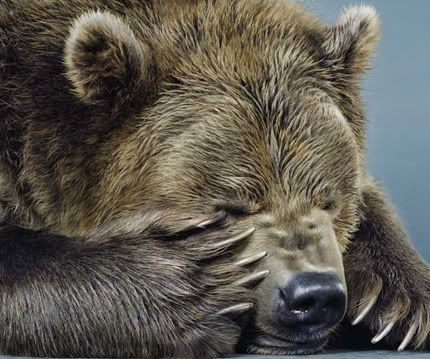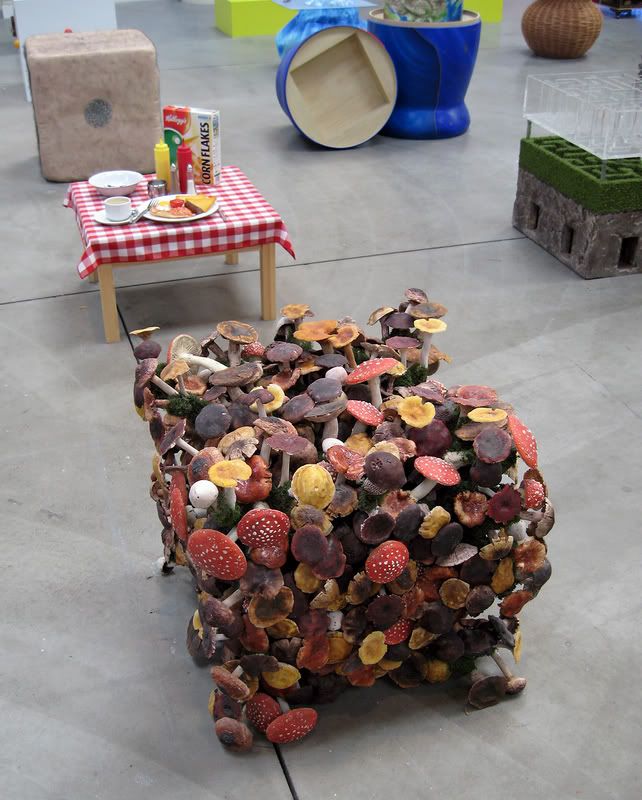
Jill Greenberg
"Untitled #7"
2006
Archival pigment print
Edition of 7
80 x 43 inches
ClampArt: Few animals possess more totemic significance than the bear. For many hunter-gatherer peoples, the bear was the supreme incarnation of Nature. But today our encounters with members of family Ursidae are contrived: we watch polar bears dully divert themselves in a zoo compound; our circuses doll up black bears in tutus and fezzes; we place cuddly, stuffed teddies in our infant's crib. Contemporary humans have enervated the animal, but the power of an enraged bear and her long, annual slumber are no less awesome or mysterious.
With "Ursine," Jill Greenberg gives these proud animals the celebrity treatment - the photographer specializes in the sort of hi-contrast, saturated images we see on billboards or in advertisement-thick glossies - but her photographs capture a range of expression in the faces and (pardon the pun) bearing of her subjects. The grizzly bear pictured in "Untitled #7" the strongest photograph in the exhibition, rears up his hind legs and lets loose a growl from a gaping, intimidating maw. Admiring those yellowed teeth, the moistened, fleshy lips, and the mottled tongue, I can almost smell the stench of being. No tutus for this fellow; this is the bear restored, a benevolent monster of the human unconscious.

Jill Greenberg
"Untitled #4"
2006
Archival pigment print
Edition of 7
43 x 50 inches
+++++
Patte Loper at Lyons Wier Ortt Gallery

Patte Loper
"We Had Pierced the Veneer of Outside Things and Scattered into a Diaspora of the Amazing"
2007
Oil on paper
80 1/2 x 58 inches
Lyons Wier Ortt Gallery: The paintings and drawings in Patte Loper's exhibition, "A New Way North," are technically commendable but lack emotional or intellectual substance. The flat, photographic color and ugly architecture featured in some works - "Glorious Predators of the Natural World," for example - are objectionable. To be fair, this may be the artist's intention. The press release informs readers that "Loper explores the pictorial and cultural intersection of glamour, modernism, cold war paranoia, and alienation." But Loper's work remains too indebted to the source material; no new life is breathed into these spaces or events through Loper's "appropriation and reproduction."
One painting, however, is exempt from such criticism. In fact, the strength of the exhibition's centerpiece, "We Had Pierced the Veneer of Outside Things and Scattered into a Diaspora of the Amazing," is what compels me to so harshly critique the other works Loper includes. "We Had Pierced..." outshines its siblings, much to their detriment.
In the painting, a large white-tailed deer (Odocoileus virginianus) rests atop a dark, Antarctic outcropping. In a glacial valley beyond, we see a partially snow-covered geodesic dome, presumably occupied (or once occupied) by human researchers. The title of the painting and the dome's construction call to mind the scientific optimism of the mid-20th century and the promise of the future. We now hold that promise in low regard and the optimism has evolved into unrestrained globalization, bringing with it the accelerated transport of contagions and so-called "invasive species," those creatures transplanted in new lands that are able to find a foothold, often displacing native niche specialists in the process.
The deer appears in all of Loper's works, included, according to the artist, "to interrupt narrative expectations," but in the case of "We Had Pierced..." the deer's presence raises questions about the work of the scientists below. Whoever lives (or lived) inside the dome "belongs" to this remote place now, as does the deer. This wasn't always so. The humans and the deer have come to this location (or were brought), and so the landscape is altered, but to what end? The slow groan of geology cradles the new inhabitants. All remains in flux. Loper's painting is a tribute to Nature's awesome compass and to our species' relative insignificance (both physical and temporal). It is as celebratory as it is ambivalent.
+++++
Keith Tyson at Pace Wildenstein

Keith Tyson
Detail of "Large Field Array"
2006 - 2007
Mixed media
Dimensions variable
Pace Wildenstein: Keith Tyson's "Large Field Array" is an exceptional work, deserving of many return visits. Though I have thought about the installation a great deal these last two days, everything I write fails to convey the work's dynamism.

Keith Tyson
Detail of "Large Field Array"
2006 - 2007
Mixed media
Dimensions variable
For all of its color, its scale, and its varied concepts, the viewing experience is a quiet, internalized one. "Large Field Array" is a polymath's revery, a virtually inexhaustible field of potential poetic connections. Tyson's worthy raison d'etre, the "joyful exploration of how everything in the world is connected," has impelled him to oversee a project that is much more than he could have hoped for. The European curator Hendrik Driessen is quoted in the gallery's press release, saying "it is a truly generous work of art." Indeed it is. In a more comprehensible, less globalized world, the work would be considered a masterpiece.
+++++
Photo credits: Jill Greenberg images courtesy ClampArt, New York City; Patte Loper image courtesy Lyons Wier Ortt; Keith Tyson images, Hungry Hyaena, 2007

3 comments:
I saw a "no photos" sign at th entrance when I went to the Tyson show. Did they just let you snap away?
Barry:
I didn't notice the sign. I'd taken about ten photos before a guard approached and asked me to stop.
You know, with all of you guys' horror stories, I'm starting to think gallery are more anti-male photography than female.
I'm constantly snapping at openings and no one says anything.
Maybe I'm that inconspicuous, or my camera is that small.
Either that, or score one for team vagina!!!
Post a Comment